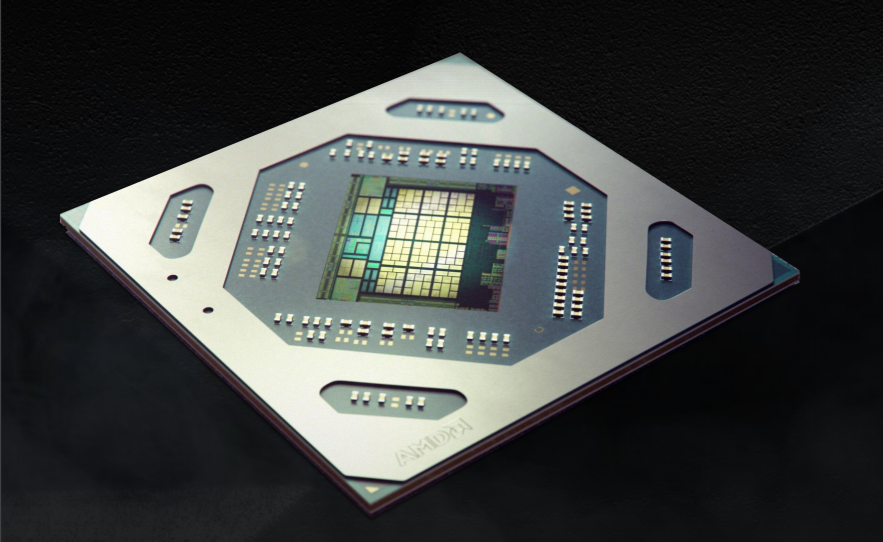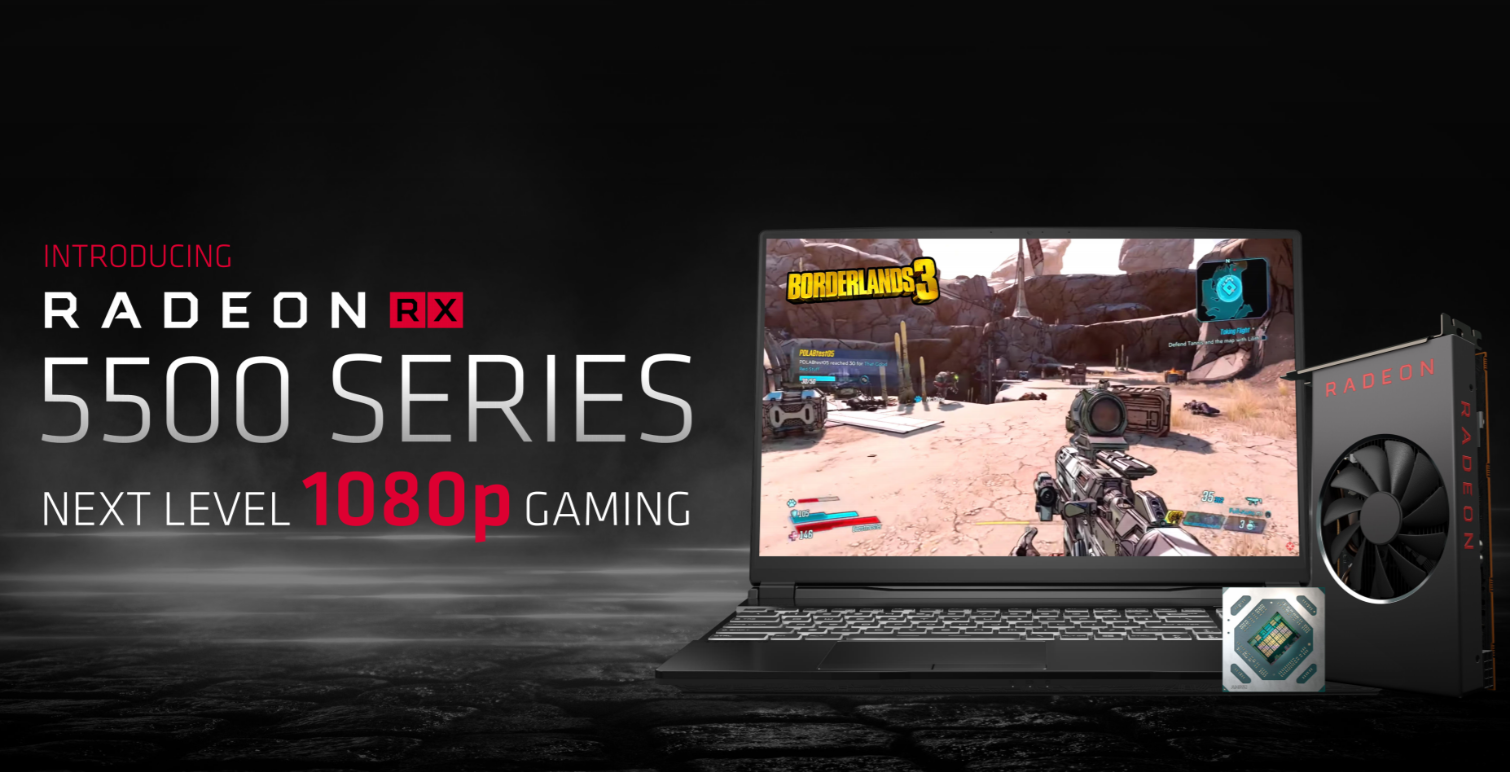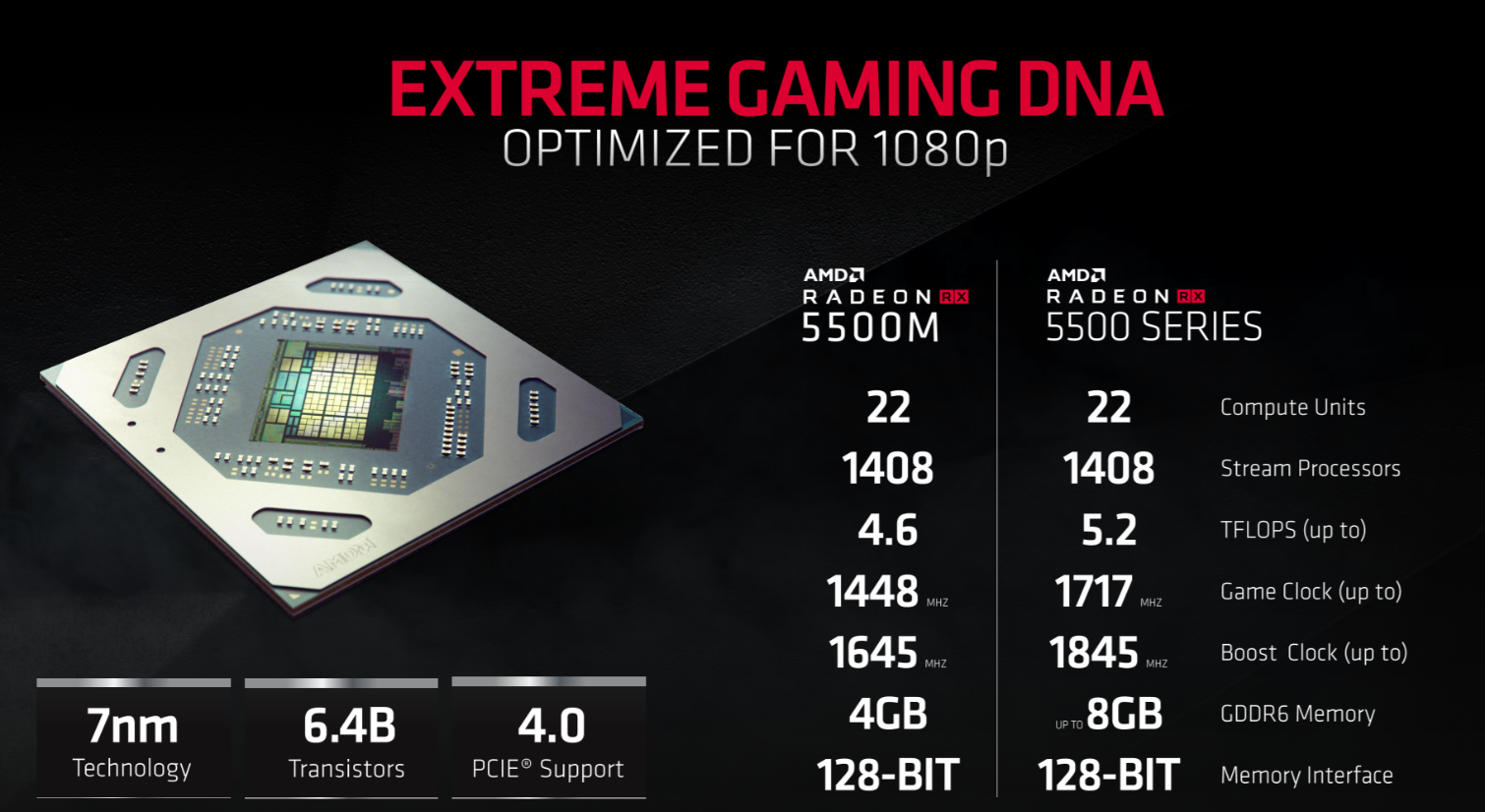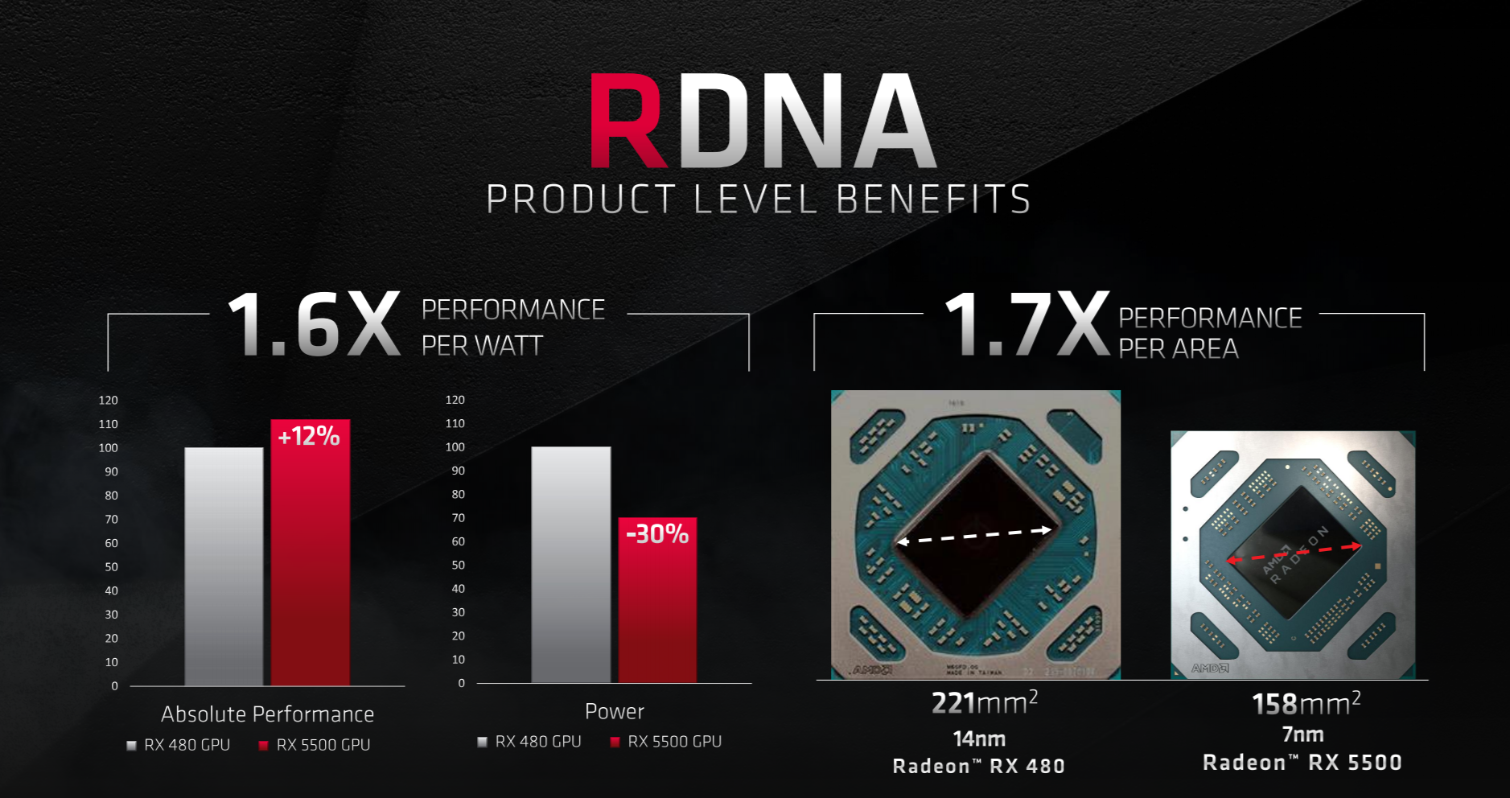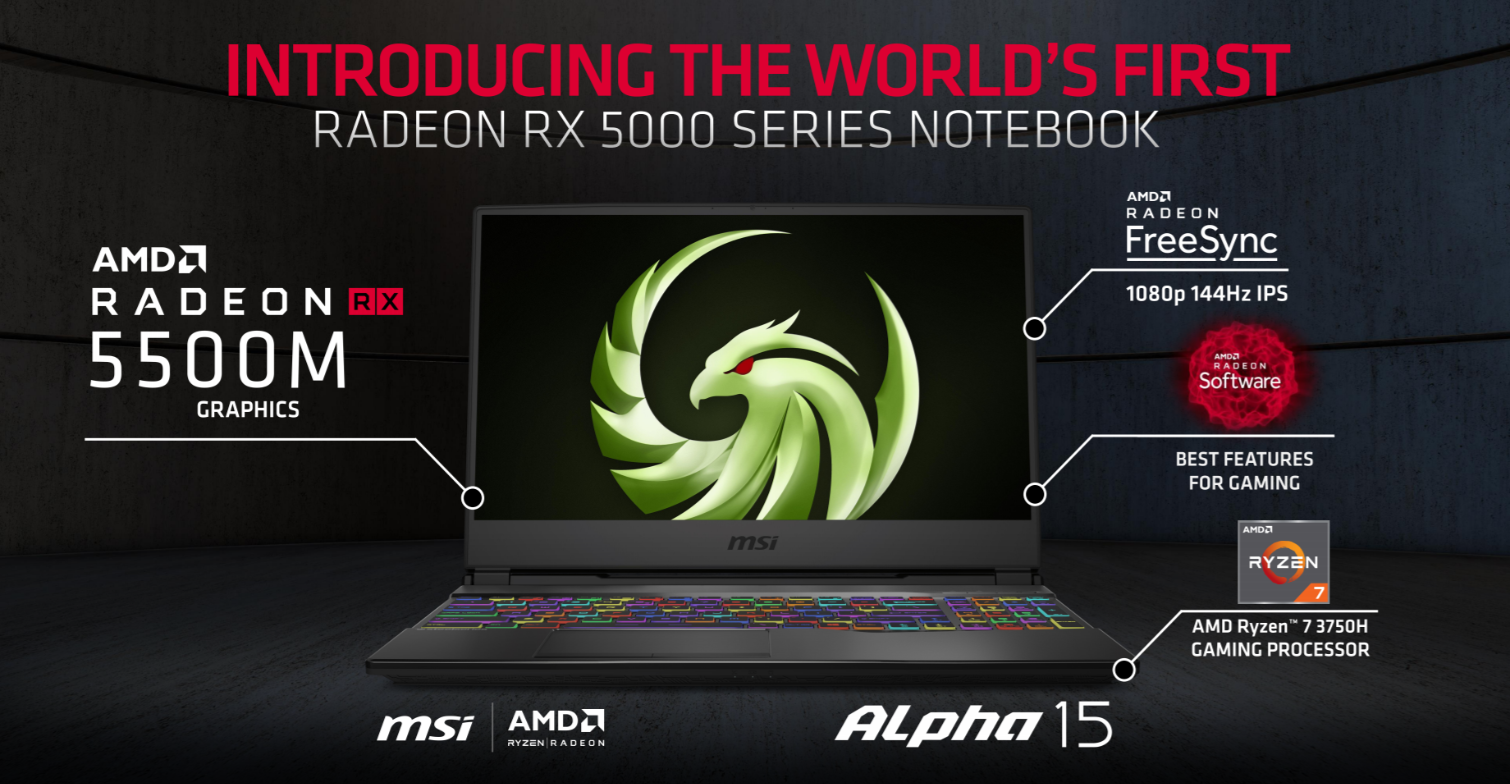Navi Goes Mainstream, Mobile: AMD’s Radeon RX 5500 Aims for Smooth 1080p Gaming
Last week, Videocardz.com reported AMD was set to release a new Navi-based GPU, the Radeon RX 5500 series, sometime in the fourth quarter. And despite the fact that we’re only a couple of days in to Q4, the company is making its new Navi part official. Announced today, the Radeon RX 5500 is intended for 1080p gameplay at a price that’s much easier on the wallet than the higher-end Radeon 5700 and 5700XT, the former of which currently starts at about $330. AMD says the RX 5500 series aims for 60 fps (frames per second) in AAA games and 90-plus fps in eSports titles at 1080p, which is still a dominant resolution for most PC gamers.
The new GPU will come in both desktop cards and a mobile/laptop variant, the latter dubbed 5500M. On the desktop side, there will only be partner cards available. In other words, we won’t see a reference model from AMD, although the company did provide references to what looks like a reference card in the press materials, which you can see below. A company rep told us cards with third-party cooling designs will be available from day one.
The desktop card will reportedly arrive with up to a 1,717 MHz Game Clock and 1,845 MHz boost clock, some models almost certainly raising those values (and thus performance) slightly. AMD says the actual clocks speeds will be somewhere between the game and boost clocks listed.
The new Navi 14-based GPU uses a PCIe 4.0 x8 bus and will sport up to 8GB of GDDR6 across a 128-bit bus. 8GB of memory is achieved over the 128-bit bus by using higher-density 16Gb chips. A 4GB version is also expected. Other specifications include 22 compute units (CUs), 1,408 stream processors (SPs) and 32 render output units (ROPs) under the hood.
| Row 0 - Cell 0 | Radeon RX 5500 | Radeon RX 5500M | Radeon RX 5700 | Radeon RX 5700XT |
| Architecture (GPU) | RDNA (Navi 14) | RDNA (Navi 14) | RDNA (Navi 10) | RDNA (Navi 10) |
| ALUs | 1408 | 1408 | 2304 | 2560 |
| Peak FP32 Compute | 5.2 TFLOPS | 4.6 TFLOPS | 7.5 TFLOPS | 9 TFLOPS |
| (Based on Typical Boost) | Row 4 - Cell 1 | Row 4 - Cell 2 | ||
| Tensor Cores | N/A | N/A | N/A | N/A |
| RT Cores | N/A | N/A | N/A | N/A |
| Texture Units | ? | ? | 144 | 160 |
| Base Clock Rate | ? | ? | 1465 MHz | 1605 MHz |
| Nvidia Boost / AMD | 1717 MHz | 1448 MHz | 1625 MHz | 1755 MHz |
| Game Rate | Row 10 - Cell 1 | Row 10 - Cell 2 | Row 10 - Cell 3 | |
| AMD Boost Rate | 1845 MHz | 1645 MHz | 1725 MHz | 1905 MHz |
| Memory Capacity | 4/8 GB GDDR6 | 4 GB GDDR6 | 8GB GDDR6 | 8GB GDDR6 |
| Memory Bus | 128-bit | 128-bit | 256-bit | 256-bit |
| Memory Bandwidth | ? | ? | 448 GB/s | 448 GB/s |
| ROPs | 32 | 32 | 64 | 64 |
| L2 | ? | ? | 4MB | 4MB |
| TDP | 150W | ? | 177W (Measured) | 218W (Measured) |
| Transistor Count | 6.4 billion | 6.4 billion | 10.3 billion | 10.3 billion |
| Die Size | 158mm² | 158mm² | 251 mm² | 251 mm² |
Performance-wise, AMD puts this card up against a GTX 1650 in order to compare it to “similarly positioned products.” In AMD’s internal testing, the RX 5500 beats the GTX 1650 (both mobile and desktop cards) by a fair amount, but does so with notably higher power consumption -- which we’ll touch on shortly. According to AMD’s press materials, we can expect 90 fps in Gears 5, 82 fps in Borderlands 3, and 60 fps in Ghost Recon: Breakpoint, while eSports titles such as Fortnite, Apex Legends, PUBG, WoW, Overwatch, and Rainbow Six: Seige are all 90 fps or above.
When asked about power use, an AMD rep stated the desktop version will have a total board power of 150W. If we compare this to the 75W rated TDP of the GTX 1650 or the 120W GTX 1660 things don’t exactly look great for AMD in terms of efficiency. Of course, we’ll have to see what actual measured power consumption and performance is when we get our hands on an RX 5500. But it seems likely the GTX 1660 will deliver similar performance while consuming roughly 20% less power.
Though power consumption looks high compared to Nvidia, AMD claims a 1.6x performance per watt and 1.7x performance per area (die size) compared with Polaris-based RX 480 GPUs. Of course, comparing brand-new silicon to something that debuted well over three years ago usually results in favorable comparisons.
Get Tom's Hardware's best news and in-depth reviews, straight to your inbox.
Cooling solutions from the board partners are said to consume two slots, as is generally the case with competing Nvidia cards. Outputs for the desktop RX 5500 will come in the form of two DisplayPorts and a single HDMI as standard. Card partners will have some freedom to change or add to this base configuration.
The mobile version will carry similar specs under the hood, but use notably lower clock speeds in order to bring power consumption and thermals to laptop-friendly levels. MSI will be first out of the gate with a mobile variant of the RX 5500M, in the form of the Alpha 15, but AMD says other companies will soon follow.
Pricing and availability still hasn’t been announced for the desktop cards. That said, given AMD’s comparison to the 1650, we expect the RX 5500 to land below $200. Additionally, AMD is offering either Borderlands 3 or Ghost Recon Breakpoint with a purchase of 5500 or 5700 series cards as part of its ongoing Raise the Game bundle.
While we’re always skeptical about day-one availability of a new graphics card, an AMD rep told us the company doesn’t expect that to be a problem here. We’ll update this post when we hear more about pricing and launch date for AMD’s new mainstream Navi parts.And of course, stay tuned for a full review.
Image Credits: AMD

Joe Shields is a staff writer at Tom’s Hardware. He reviews motherboards and PC components.
-
Aspiring techie Per AMD's site, it looks like the TBP will be 110W. I don't know if the press was given bad info, or if the 150W TBP is referring to a different card/configuration.Reply -
cryoburner ReplyPerformance-wise, AMD puts this card up against a GTX 1650 in order to compare it to “similarly positioned products.” In AMD’s internal testing, the RX 5500 beats the GTX 1650 (both mobile and desktop cards) by a fair amount, but does so with notably higher power consumption.
The 1650 probably isn't a fair comparison in terms of load power efficiency, since this card seems to be targeting a notably higher level of performance, even if the price ends up being similar. It's difficult to say exactly how the 5500 will perform until reviews are out, but based on its specs, along with AMD's suggestion of it being over 12% faster than an RX 480, I would suspect average performance to not be too far behind that of an RX 590, a card that's around 40% faster than a 1650. I don't expect it to be as fast as a 1660, and efficiency might not be quite as good either, but efficiency isn't likely to be different enough from that card to be a major concern. The real deciding factor will be the price to performance ratio. -
vaughn2k TDP at 150W?? This should be the TDPs of the RX 5700.Reply
RX 460s and 560s before were like 75W and RX 550s at 50watts.
I've been waiting a low profile, low power from AMD after the RX 460, and there is still no competition of the GTX 1650 75W low profile arena, even the 1050Ti Low profile at 75W is still king!
this is sad... -
bit_user Reply
AMD doesn't care enough about low-profile. After a while, a couple low-profile RX 560's did appear, but they might've been the 14-CU variant (RX 560's normally have 16 CUs).vaughn2k said:I've been waiting a low profile, low power from AMD after the RX 460
Yeah, it was a good, little card. We got some MSI dual-fan versions, at my job.vaughn2k said:even the 1050Ti Low profile at 75W is still king!
Teslas P4's (like a lower-clocked GTX 1070 with 16 GB) and T4's (like a lower-clocked RTX 2070 Super with 16 GB) are both low-profile, single slot. I wish they'd add a fan & display port and sell them as Quadros. They'd probably have to get a bit wider and longer, but that'd be fine. -
King_V The original 150W power consumption number definitely seems a little weird, relative to the 5700. I understand that trying to push performance higher results in an increase in power consumption greater than the increase in performance - I would've assumed that cutting things back would result in a better performance/power-consumption profile....Reply
The one example I can think of is the Vega 56:
Using the secondary BIOS with a power limit reduced by 25% gets us 159.4W and 32.7 FPS. Compared to the stock settings, just 71.6% of the power consumption serves up 89% of the gaming performance.
So I find the estimates a little baffling. Still, we don't know exactly what the 5500's performance will be.
This is probably a VERY sloppy way of doing this, but, I'm going to make some guesstimates based on the scoring of various cards on the GPU hierarchy chart relative to the 5700 (score of 87.5), and then multiply the 5700's TDP (180W) by the resulting number. Obviously, this assumes that the score on the hierarchy chart is absolutely accurate, and that power consumption is directly proportional to performance as measured by that score number - take this with an enormous boulder of salt, in terms of how good this estimate might be.
If the RX 5500 performs the same as:Performance scoreScore percent (Perf score/Perf score-of-5700)TDP estimate (180 x Score percent)RX 570087.5100%180WGTX 1660Ti71.481.6%147WGTX 166063.672.7%131WRX 59060.769.4%125WRX 580 8GB57.966.2%119WGTX 1060 6GB53.260.8%109WRX 570 4GB48.355.2%99WGTX 165042.248.2%87W
